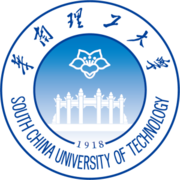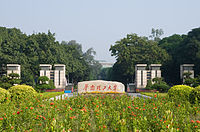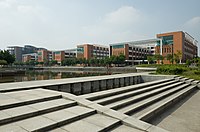South China University of Technology
华南理工大学 | |
 | |
Former names | South China Institute of Technology[1] |
|---|---|
| Motto | 博学慎思 明辨笃行 |
Motto in English | Study Extensively, Enquire Accurately; Discriminate Clearly, Practise Earnestly |
| Type | Public coeducational |
| Established | 1952 |
| President | Wang Yingjun |
Academic staff | 4,511[2] |
| Undergraduates | 24,906[2] |
| Postgraduates | 18,689[2] |
| Location | , , |
| Campus | Urban,2.95km²[2] |
| Affiliations | Project 985, Project 211, The Excellence Union |
| Website | www en |
South China University of Technology (SCUT; simplified Chinese: 华南理工大学; traditional Chinese: 華南理工大學; pinyin: Huánán Lǐgōng Dàxué, orally known as Huágōng 华工) is a major public university in China. It is located in the Tianhe District and Panyu District of Guangzhou, capital of Guangdong Province, China. It is a multidisciplinary university focusing on engineering, combined with science, also promoting well coordinated development of management, economics, humanities and law.[1] Its engineering ranks top 50 among world universities according to Academic Ranking of World Universities (ARWU). [3]
History
- Formerly known as the South China Institute of Technology(华南工学院), it was established in 1952, through a reorganization process that unified the engineering schools and departments of major universities from five provinces in central and Southern China, including the former National Sun Yat-sen University, Lingnan University, Hunan University, Guangxi University, South China Joint University, and four others.

- In 1960, it was selected as one of 33 National Key Universities, under the direct administration of the Chinese Ministry of Education.
- The University was renamed as South China University of Technology in 1988.[1]

- In 1995, it was selected as one of the universities into which China will make significant investment in the 21st century as part of Project 211.
- In 1999, it was rated "excellent" during the Undergraduate Teaching Assessment, and was among the first "Excellent Universities of Undergraduate Education" in the country. In the same year, a national science park was established with the authorization of the State Ministry of Technology and State Ministry of Education.
- In 2000, authorization was given for the establishment of a Graduate School.
- In 2001, it became one of the 39 national universities sponsored by Project 985.
Rankings
- The university ranked 300-400th according to the 2015 Academic Ranking of World Universities (ARWU). In particular, its engineering was ranked 48th, and chemistry 101-150th among world universities.[4]
- The 2014 Best Global Universities Rankings (usnews) ranked South China University of Technology 400-450th, with its engineering placed at 68th.[5]
- The university ranked 300-400th among world universities according to the 2014 ARWU. Its engineering was among the top 50 according to the same ranking.[6]
- In the 2013 Leiden Ranking of universities according to the proportion of their scientific publications that rank among the top 10% in their field, SCUT was ranked 138th in the world, 11th in Asia, and 5th in China (excluding Hong Kong) behind Nankai University, Hunan University, University of Science and Technology of China, and Lanzhou University.[7]
- The same year's QS University Rankings placed the university at 151-160th.[8]
Campuses and Schools
There are two SCUT campuses, both located in Guangzhou: Wushan Campus (or North Campus) and Guangzhou Higher Education Mega Center Campus (or South Campus). The headquarters of the university are on the Wushan Campus.[9] Of SCUT's 27 schools, 16 are located on the Wushan Campus, while the remaining 11 schools are on the Guangzhou HEMC Campus.[2]
Wushan Campus (North Campus)

This campus was formerly part of the National Sun Yat-sen University campus, and many buildings remain from that time.
Address: Wushan Rd., Wushan Subdistrict, Tianhe District, Guangzhou
Area: 1.83km²[2]
16 schools:
- School of Architecture
- School of Automation Science & Engineering
- School of Business Administration (Association of MBAs accredited)[10]

- School of Chemistry and Chemical Engineering
- School of Civil and Transportation Engineering
- School of Electric Power
- School of Electronic and Information Engineering
- School of Foreign Languages
- School of Ideology and Politics
- School of Light Industry and Food Science
- School of Materials Science and Engineering
- School of Mathematics
- School of Mechanical & Automotive Engineering
- School of Physical Education
- School of Physics and Optoelectronic Technology
- School of Public Administration
Guangzhou Higher Education Mega Center Campus (South Campus)

Address: Guangzhou Higher Education Mega Center or Xiaoguwei Subdistrict, Panyu District, Guangzhou
Area: 1.12km²[2]
11 schools:[11]
- School of International Education
- School of Arts
- School of Bioscience and Bioengineering
- School of Computer Science & Engineering
- School of Design
- School of Economics and Commerce
- School of Environment and Energy
- School of Journalism and Communication
- School of Law
- School of Software Engineering
- School of Medicine
Alumni
Politicians and Military
- Cheng Siwei – Vice Chairman of The National People's Congress
- Wan Qingliang – Former mayor and CCP secretary of Guangzhou City
- Lin Shusen – Former Governor and Deputy Communist Party Chief of Guizhou Province
- Wei Gang – Former minister of the General Armaments Department of the People's Liberation Army
Athletes
- Chen Ding – 2012 Summer Olympics gold medallist in the 20 kilometres walk
Scholars
- He Jingtang – Dean of School of Architecture of SCUT, Member of China Academy of Engineering and the main designer of the acclaimed China Pavilion at the 2010 Shanghai World Expo.[12]
- Thomas Hou – Charles Lee Powell Professor of Applied and Computational Mathematics at the California Institute of Technology
- Chen Feng – Vice-dean of College of Engineering of Peking University
- Tang Benzhong – Member, Chinese Academy of Sciences. Fellow, Royal Society of Chemistry. Chair Professor, Department of Chemistry at The Hong Kong University of Science & Technology
Businessmen
- Li Dongsheng – CEO of TCL Corporation
- Fang Guiquan – President of Guangzhou Zhujiang Brewery Group
- Zhu Jianghong – Chairman of Gree Electric
- Hu Zheyi – Executive vice president of China Construction Bank
- Liang Zhaoxian – CEO of Galanz
- Zhang Zhidong – Former CTO of Tencent
- Ding Anhua – Vice-president of China Merchant Securities
- Chen Dongfeng – Vice-president of Evergrande Real Estate Group
- He Xiaopeng – Co-founder and president of UCWeb Inc.
References
- ^ a b c "Introduction".
- ^ a b c d e f g "Facts&Figures"., SCUT, April.2013
- ^ http://www.shanghairanking.com/FieldENG2015.html
- ^ http://www.shanghairanking.com/FieldENG2015.html
- ^ http://www.usnews.com/education/best-global-universities/south-china-university-of-technology-505115
- ^ http://www.shanghairanking.com/FieldENG2014.html
- ^ "CWTS Leiden Ranking 2013". Centre for Science and Technology Studies (CWTS) and Leiden University. Retrieved 19 March 2014. For details on the survey's methodology, see "Data collection".
- ^ "South China University of Technology Rankings", QS Asian University Rankings, 2013
- ^ "Campus Maps".SCUT, April.2013
- ^ "About the School - Introduction"., 2013
- ^ "South Campus Introduction". (Chinese), SCUT, Dec. 2012
- ^ "Professor He Jingtang".
